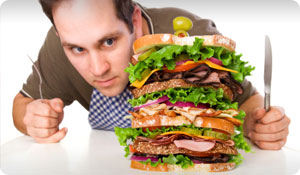
For better health and weight control, serving size really does matter. Even if you eat healthy foods all day long, you may still gain weight if you don't pay attention to how much you're consuming. Too many people fall into the trap of portion distortion: accepting extra large portions as normal.
Standard portions have increased over the years. But what's surprising is just how much they've increased and how many more calories are being consumed today because of it. For example, in 1916 a standard bottle of coke was 6.5 ounces and 78 calories compared with today's serving of 20 ounces and 240 calories.
According to the National Heart, Lung, and Blood Institute (NHLBI), a "portion" is how much food you choose to eat at one time. A "serving" size is the amount of food listed on a product's Nutrition Facts label. The U.S. Food and Drug Administration (FDA) Nutrition Facts information is printed on most packaged foods and tells you the amount of calories, fat, carbohydrates, sodium and other nutrients are in one serving of the food. Most packaged foods contain more than one single serving in a package.
To help you control how much you eat, it helps to visualize serving sizes. So, what is the truth about serving sizes? Use the following guidelines:
- A cup of cereal is about the size of a baseball or your fist.
- A half cup of cooked rice or pasta or fruit or cooked vegetables is about the size of ½ of a baseball.
- A medium piece of fruit is the size of a baseball.
- 1 ½ ounces of cheese is about the size of 4 stacked dice.
- ¼ cup dried fruit is about the size of an egg.
- 3 ounces of meat is about the size of a deck of cards.
- 2 tablespoons of peanut butter or salad dressing is about the size of a ping pong ball.
- 1 teaspoon of butter, margarine, or oil is about the size of one die.
Choosing smaller servings or sharing ordinary servings, especially of high fat and high sugar foods, makes a major difference in your overall calorie intake. Consider these calorie comparisons:
- Small fry = 225 calories versus large fry = 515 calories
- Regular cheeseburger = 330 versus quarter pound cheeseburger = 515
- 12 oz. coke (child's size) = 115 calories versus 32 oz. (large) = 310 calories
Remember, the portion sizes you're used to eating may be equal to 2 to 3 serving sizes. Keep a food diary and use measuring spoons and cups to help assess your intake. Visit a Registered Dietitian for a thorough nutrition evaluation of your calorie intake.
__________________________________________________________________________________
Sources:
1. http://win.niddk.nih.gov/publications/just_enough.htm#difference





